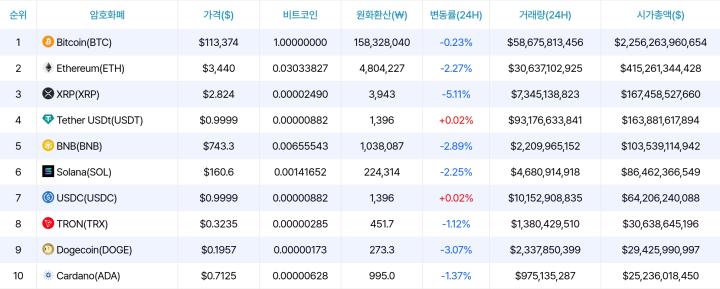The cryptocurrency market in August seems challenging from the very beginning. Last week, Bitcoin's price dropped sharply, breaking out of the $117,000-$120,000 range it had formed since July 11th. Bitcoin's price fell nearly 4% weekly, and some altcoins even dropped by more than 15%.
This week's decline occurred in two main stages. One was the statements made by Federal Reserve Chair Jerome Powell after the July Federal Open Market Committee (FOMC) meeting on July 30th. While the market had been expecting a high probability of a rate cut in September after July's rate freeze, Powell effectively "poured cold water" on those expectations.
Powell said he was still uncertain about the possibility of a September rate cut. He acknowledged the potential for an economic downturn but explained that keeping rates unchanged was reasonable because the inflationary effects of tariffs had not yet been confirmed.
Additionally, he emphasized that the "labor market is still solid and close to balance" and that it was time to be more concerned about price risks than employment.
Interestingly, there was strong pushback within the Federal Reserve itself. Christopher Waller and other board members argued that while the labor market appears healthy on the surface, considering data adjustments, private sector employment growth has significantly slowed, advocating for preemptive rate cuts.
For now, those who think like Powell remain the majority at the Fed, and the market had to abandon its expectations for a September rate cut. Bitcoin's price dropped to $115,800.
The second decline was caused by the Non-Farm Payroll (NFP) report on the 1st. While Wall Street expected around 110,000 jobs in July, only 73,000 were reported, contradicting Powell's explanation and indicating a significant deterioration in US employment.
The real issue was the massive downward revision of May and June data by 258,000 jobs. June's NFP, which initially seemed strong at 147,000, was mostly fictitious. The Bureau of Labor Statistics revised June's NFP to 14,000 and May's to 19,000 - the lowest in the past five years.
The official unemployment rate was 4.2% as expected, but the comprehensive unemployment rate (U-6) reached 7.9%, the highest since the COVID-19 pandemic. Long-term unemployment and job seeker numbers also worsened. The US stock market crashed on these indicators signaling a strong economic recession and employment decline. Bitcoin retreated to the $112,000 range that day.
Corporate Purchases and ETFs That Led the Rise... Falling with Macro Indicators
The cryptocurrency industry was dragged along by these broader macroeconomic trends. The spot ETFs that drove Bitcoin and Ethereum prices in July saw significantly reduced inflows after the 30th. On the 1st, it even recorded the largest daily outflow since February this year.
Companies buying Ethereum also collapsed. The week actually started on a positive note. Sharplake Gaming confidently added $300 million in Ethereum purchases and staking, and Bitmain, led by CEO Tom Lee, claimed Ethereum's intrinsic value is $60,000.
Standard Chartered Bank noted that listed companies are aggressively buying Ethereum, projecting they will hold 10% of the total Ethereum supply. Strategic Ethereum reserves by companies have exceeded $10 billion, a 50-fold increase in the past four months.
However, they were powerless against the late-week crash. Ethereum's price dropped 7.2%. Top two Ethereum accumulation companies Sharplake Gaming (-30.80%) and Bitmain (23.16%) also saw significant stock price declines.
Predictably, pessimism is now circulating in the market. Crypto influencer Arthur Hayes, Bitmex founder, forecast Bitcoin could drop to $100,000 and Ethereum to $3,000, citing potential economic burden from US tariff bills and slow credit expansion globally.
Over the weekend, on-chain data showed Ethereum's holder accumulation rate hit a two-month low at 27.57%, indicating investors are no longer actively increasing their ETH holdings.
Market Already Reflects Three Rate Cuts This Year... US Market Resilience is Key
The warm July atmosphere has completely disappeared with this sudden decline. How will cryptocurrency prices fare this week? The key will be whether the US stock market can rebound on Monday night after the shock of the NFP data revision.
The US Bureau of Labor Statistics previously revised nearly 800,000 NFP jobs last August. Essentially, jobs that didn't exist were reported as if they did for a year. However, when this was revealed, it didn't cause significant stock market fluctuations.
The significant Friday decline may also be due to the recent US stock market's smooth performance in setting new highs. The market was ripe for adjustment, and the poor employment indicators conveniently provided the trigger. If the US stock market recovers without further correction, the cryptocurrency market is likely to rebound as well.
However, if further adjustments continue here, the remarks by Powell, the Federal Reserve Chairman, who dismissed the possibility of a September rate cut while emphasizing the strength of US employment, will become important. The FedWatch tool from the CME exchange already predicts the possibility of rate cuts within the year at three times.
There are no significant macroeconomic issues this week. However, as employment issues in the United States have become a matter of utmost concern, the Conference Board Employment Trend Index to be released on the 4th (Monday) night is expected to have a significant impact on the US stock market. We wish our readers a successful investment this week as well.






